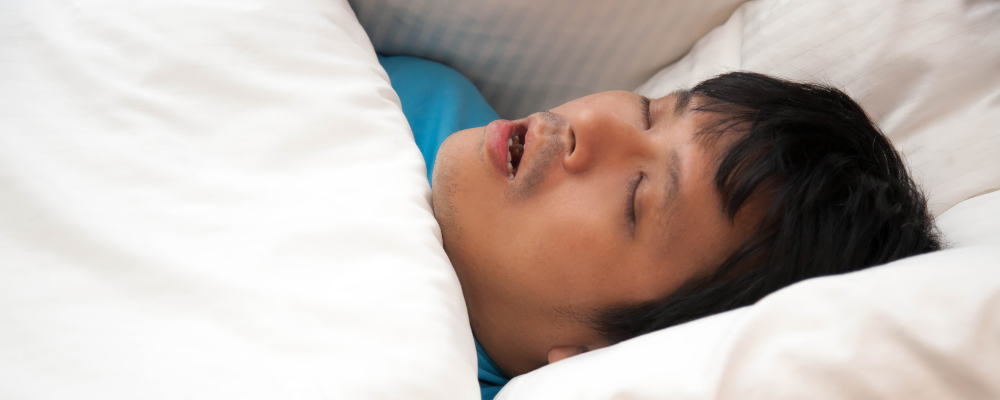Research published within the National Institutes of Health (NIH) states, “22 million Americans have sleep apnea, and 80% don’t know it.” Why? Well, sleep apnea is difficult to diagnose, because it’s a sleep disorder. That means it occurs while you’re sleeping. But how can you be expected to know you have a life-threatening illness if you’re not conscious when it happens?
Luckily, there are sleep apnea symptoms you can identify during the day, and if you have a bed partner, you can ask them to keep an eye out at night. In today’s blog, Aeroflow Sleep will cover what sleep apnea is, who gets sleep apnea, when to see your doctor for untreated sleep apnea, and how treating it could actually save your life if you are one of the 22 million.
Table of Contents
What is sleep apnea?
There are 3 types of sleep apnea: obstructive sleep apnea, central sleep apnea, and mixed sleep apnea. Let’s break down what each is:
1. Obstructive Sleep Apnea
Obstructive Sleep Apnea (OSA) is most common. It occurs when throat muscles relax and collapse and is usually caused by something literally obstructing your upper airway. Obstructions can be anything from enlarged adenoids or tonsils to a shallow soft palate to a fatty neck putting pressure on your throat.
2. Central Sleep Apnea
Central Sleep Apnea (CSA) occurs when the brain fails to send signals to breathing muscles. This may mean your breathing pauses, you stop breathing altogether, or you simply have difficulty inhaling or exhaling while asleep.
3. Mixed Sleep Apnea
Finally, Mixed Sleep Apnea, which the Mayo Clinic calls Complex Sleep Apnea Syndrome or Treatment-Emergent Central Sleep Apnea, occurs when you have both OSA and CSA. This is the most severe form of sleep apnea.
Who gets sleep apnea?
Anyone can get sleep apnea regardless of age, weight, or gender. However, some factors do make you more likely to get it. These are called risk factors and may include comorbidities like:
- Obesity or excess weight
- Type 2 Diabetes
- High Blood Pressure
- Heart disease
- A family history of any of the above
Other health problems can put you at a higher risk for sleep apnea too, of course, but these are the most common. And the most common patient is an overweight man over the age of 50. If this sounds like you, keep reading; you may be surprised to find the symptoms also match.
What are the symptoms of sleep apnea?
Symptoms of sleep apnea include:
- Loud snoring
- Chronic daytime sleepiness
- Weight gain
- Hypertension
- Awakening with a morning headache, dry mouth, or sore throat
- Gasping or choking during the night
- Irritability or mood swings
- Insomnia
This does vary from person to person though. For example, loud snoring is typically a sign of sleep apnea, but you may have sleep apnea without this symptom. In fact, not everyone who has sleep apnea snores! Question is…are your symptoms harmless or not?


Is sleep apnea dangerous?
Yes, sleep apnea can be dangerous. Heart attack, stroke, even pulmonary embolisms are all very serious medical conditions sleep apnea can lead to. Truth be told, every type of sleep apnea can lead to a 3-fold increase in risk of death, and to ensure this doesn’t happen to you, know when to see your doctor.
When to See Your Doctor
If you or your bed partner suspects any of your symptoms are linked to sleep apnea, you need to see your doctor right away. As previously mentioned, doing so may prevent health problems; like an increased risk of heart failure or arrythmias.
Still unsure if you’re at risk for sleep apnea? This stop-bang questionnaire can assess your risk. Feel free to bring it to your next checkup, review the answers with your doctor, and be confident in your healthcare together.
Can I test myself for sleep apnea?
You, yourself, cannot confirm whether or not you have sleep apnea. Only a sleep study can properly diagnose this medical condition and is what your doctor will recommend if they think you have sleep apnea. That said, a sleep study can be done in-lab or at home.
A sleep study works by monitoring your breathing pattern, airflow, oxygen levels, and heart rate while you sleep. In-lab sleep studies track more kinds of information too, but that also means they require more sensors and observation than those done at home. The smallest versions of at-home sleep studies only use a fingertip sensor.
So, while an at-home sleep study is certainly more comfortable, there are cons: 1) it will only diagnose sleep apnea and not any other sleep disorders, 2) it is less likely to identify mild sleep apnea, and 3) some insurance companies may not accept the results. The latter is especially important, because your sleep apnea treatment could be covered by insurance.
How is sleep apnea treated?
Continuous positive airway pressure (CPAP) is how sleep apnea is most often treated, and this sleep medicine could save your life. It is prescribed in the form of a CPAP machine, which pushes air pressure through a hollow tube to an attached CPAP mask and into your upper airways, via your mouth and/or nose.
Surgery, oral appliances, or neuromuscular stimulation are also treatment options, and if you suffer from any of the aforementioned comorbidities associated with sleep apnea, lifestyle changes that promote a healthy diet and weight loss could further reduce your breathing problems. Except, these solutions are less likely to be covered by insurance.
Aeroflow Sleep specializes in covering CPAP supplies–including CPAP machines–up to 100% through insurance. Plus, our expert Sleep Specialists guide you through every step of your sleep apnea journey, because therapy this vital is not something you want to mess around with alone.
Become a part of the Aeroflow Sleep family today by filling out our Qualify Form or calling us at (800) 480-5491. We’re ready to help identify your sleep apnea symptoms and get you the treatment that could actually save your life today.











